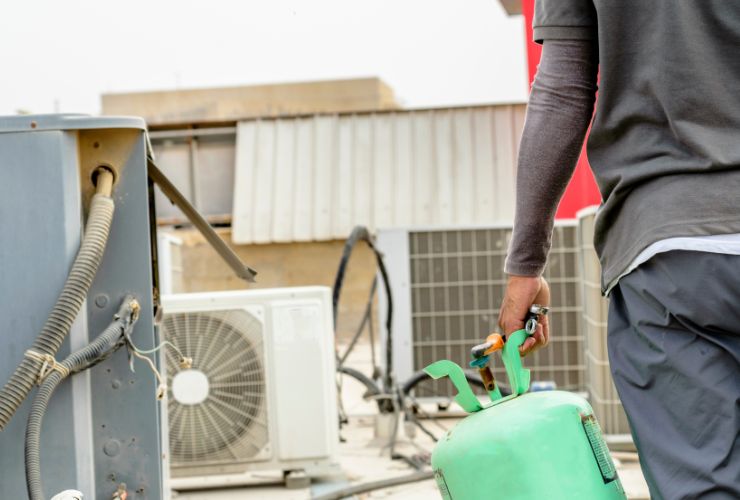Fast read
Air conditioners employ refrigerants to absorb hot air and transform it into cool air. R-32, R-22, and R410a are the three most typical varieties.
R-22 is combustible when exposed to air or oxidising substances. However, R-32 is classified as extremely somewhat flammable. When mixed with air under pressure or subjected to strong ignition sources. R410a, which is usually not a flammable gas, can become so.
Other refrigerants with varied flammability levels include carbon dioxide, ammonia, R-600a, R-290, and R-1270.
Adhering to correct installation and safety precautions is crucial to avoid potential risks like fires, injuries to people, and property damage. When buying air conditioners or other energy-related products. Please ask for guidance from a local installer.
Is there flammable gas in my air conditioner?
When we discuss “air conditioner gas,” we are referring to the special substance inside that enables your AC to function. Three common types of refrigerant are R-32, R-22, and R410a. Now, let’s address the significant question: is this gas flammable, and does it pose a fire risk?
R-32 is a bit flammable, but it’s not a huge risk because it’s sealed tightly in your air conditioner. The chance of a fire is extremely low.
R-22 is different—it can catch fire when it touches air or certain materials. That’s why it’s not used as much anymore because of safety and environmental concerns.
R410a is safe and not considered a flammable gas, which makes it a good choice for modern air conditioners. So, in simple terms, the risk of a fire depends on the type of gas your AC uses. Always follow safety rules to stay on the safe side.
R-32
When considering R-32 refrigerant gas, it’s crucial to note its slight flammability, primarily because its significant component, difluoromethane, is a highly flammable gas. This refrigerant, commonly found in air cons, is stored under pressure within a sealed cylinder to prevent any potential refrigerant leak into the surrounding air. The pressurisation is a safety measure to avoid risks associated with its flammability.
While there’s a theoretical risk of the cylinder exploding if it gets too hot, it’s essential to highlight that such occurrences are exceedingly rare, contributing to an overall negligible level of risk. Regular maintenance and adherence to safety protocols further mitigate potential hazards associated with R-32.

The R-22 refrigerant
This refrigerant has a unique characteristic – it can become combustible if it comes into contact with air or other materials that make things catch fire. To put it in perspective, R-22 is a heavyweight in environmental impact, being a staggering 1810 times more potent than carbon dioxide, the gas we naturally release.
However, the good news is that as long as your air conditioner is properly sealed and contains R-22, there shouldn’t be any issues. The key here is to ensure that the refrigerant remains safely confined within the system.
R-410A
R-410A is rated as not flammable at atmospheric pressure and ambient temperatures. However, the refrigerant can become a flammable gas when exposed to strong ignition sources or mixed with air under pressure. Just like R-22, there is no reason to worry as long as R-410A does not leak from your air conditioner unit and comes into contact with something that causes a chemical reaction.

Other potentially flammable gas refrigerants
We’ve discussed some usual refrigerants, but there are more options out there. Take carbon dioxide (CO2), a cool choice because it’s not flammable, and it only gets a bit risky if there’s a lot of it around. Since some other refrigerants can harm the ozone layer, people think CO2 might become more popular in the future because it’s kinder to the environment.
Ammonia is another option as a refrigerant, but it requires caution because it’s known to be explosive. People don’t use it much in air conditioners due to its explosive nature.
Now, let’s discuss R-600a, R-290, and R-1270, they all have something called hydrocarbon, which means they can catch fire. Even though they can be considered flammable gas, R-600a and R-290 are still used in everyday fridges and freezers. You just need to be careful and make sure everything’s safe when using these kinds of refrigerants.
In the world of cooling, these different options are like ingredients in a recipe. People are looking for ways to keep things cool without hurting the planet, and these refrigerants play a part in figuring out the best way to do that. Keep an eye out for these cool choices as the world keeps searching for better, safer, and more eco-friendly ways to keep things chilly.
Potential hazards
These natural alternatives have distinct hazard characteristics from the routinely utilised HFCs. They range from severe toxicity to high flammability. Therefore, if an air conditioning repair person is converting or changing a flammable refrigerant system, they must recognise the associated risks and implement all safety considerations.
If this does not occur, such failures could result in fires, personal harm, and property damage. Therefore, additional safety measures are necessary for equipment and systems that use flammable refrigerants.



